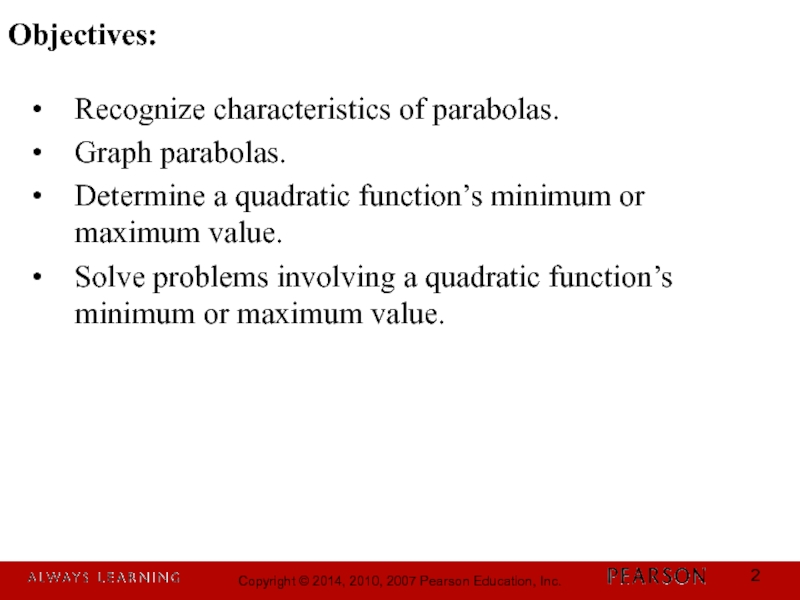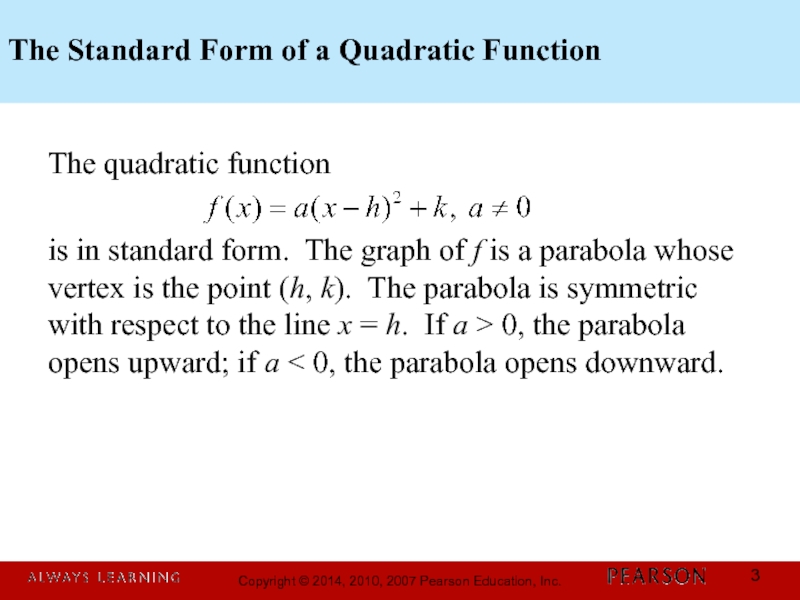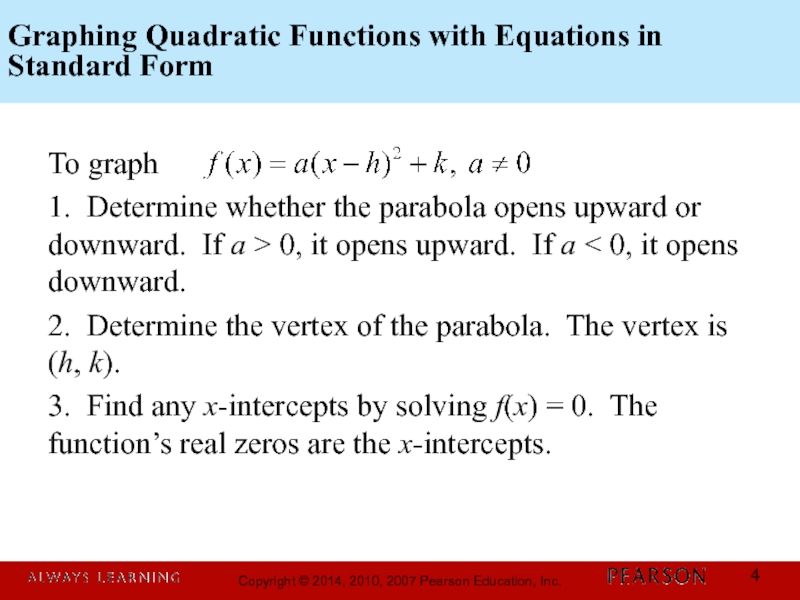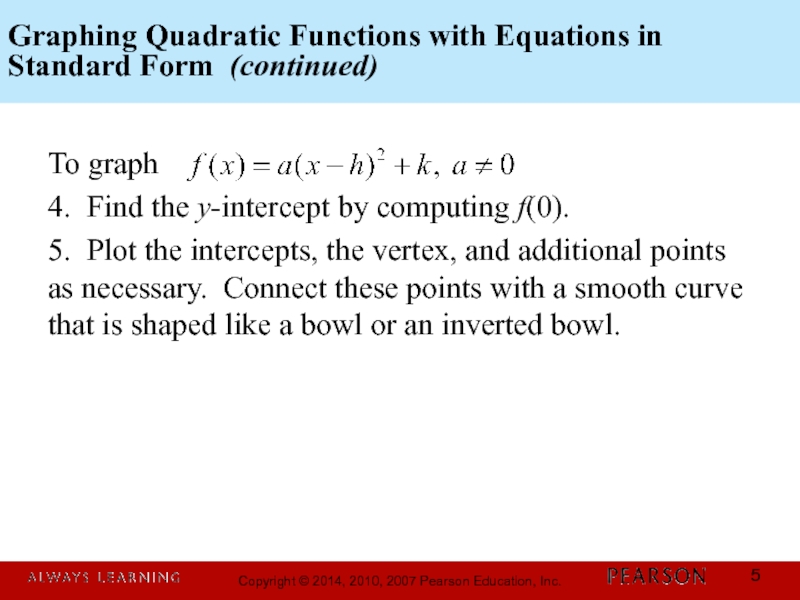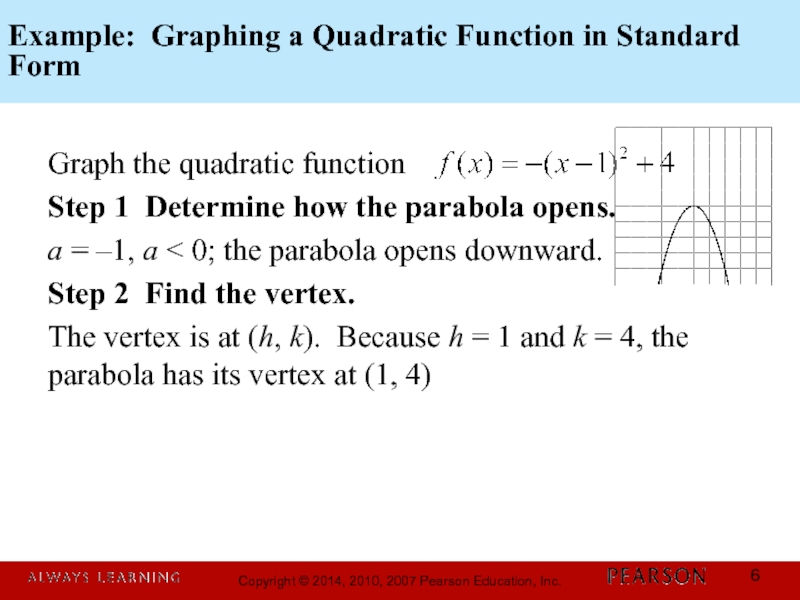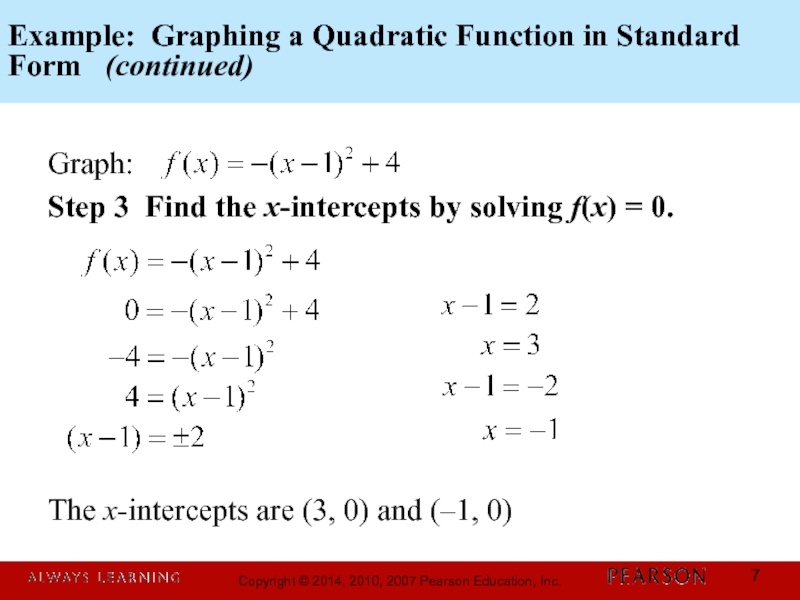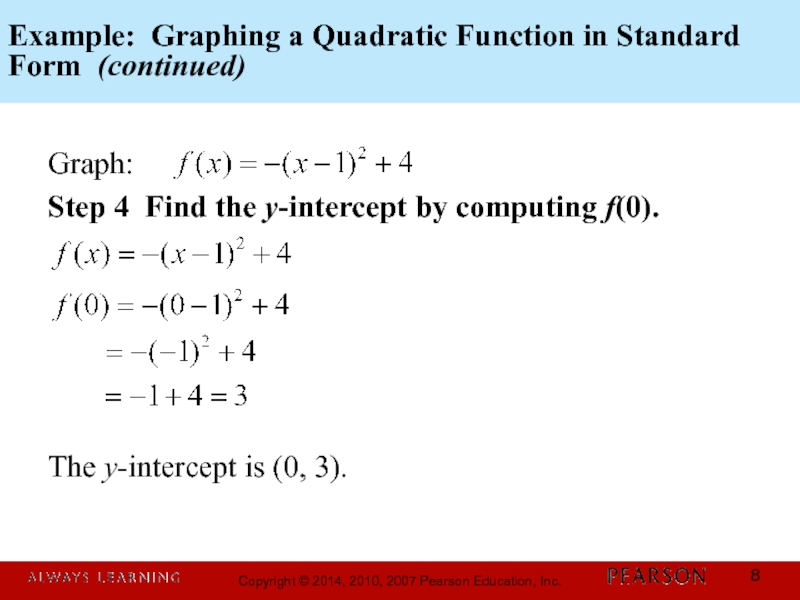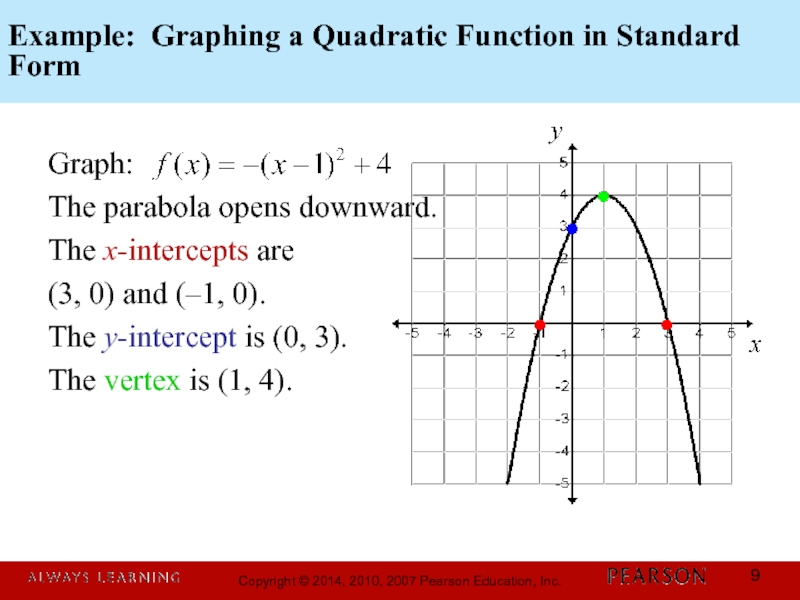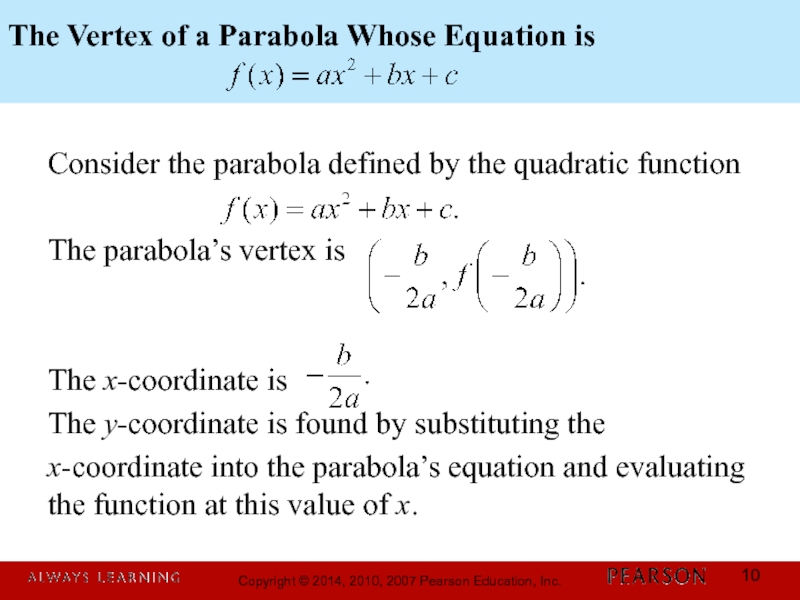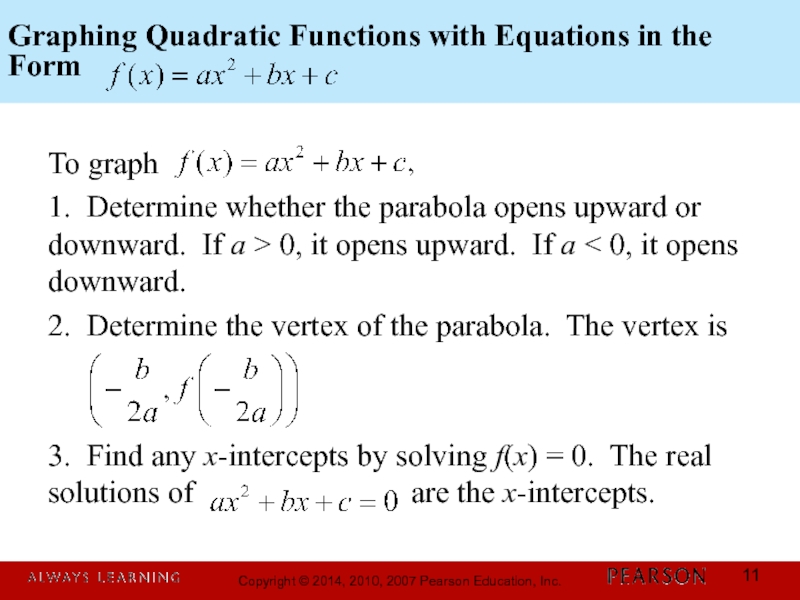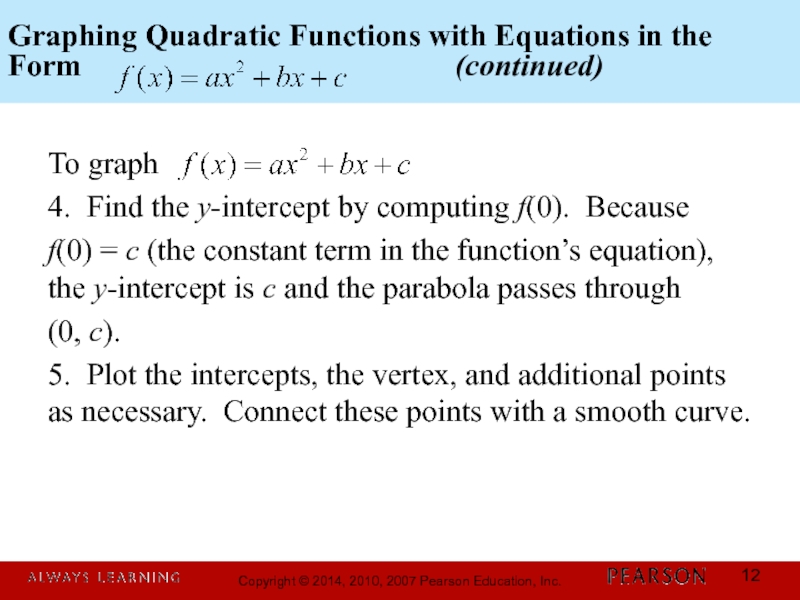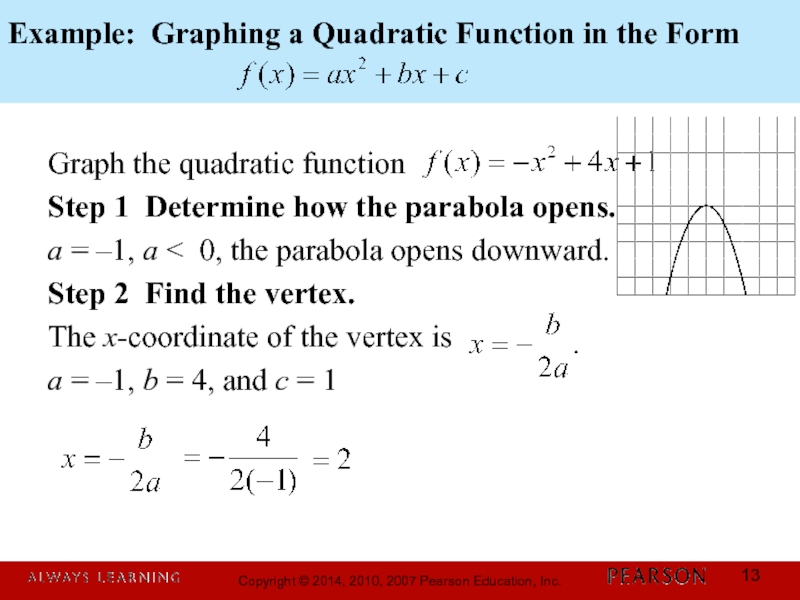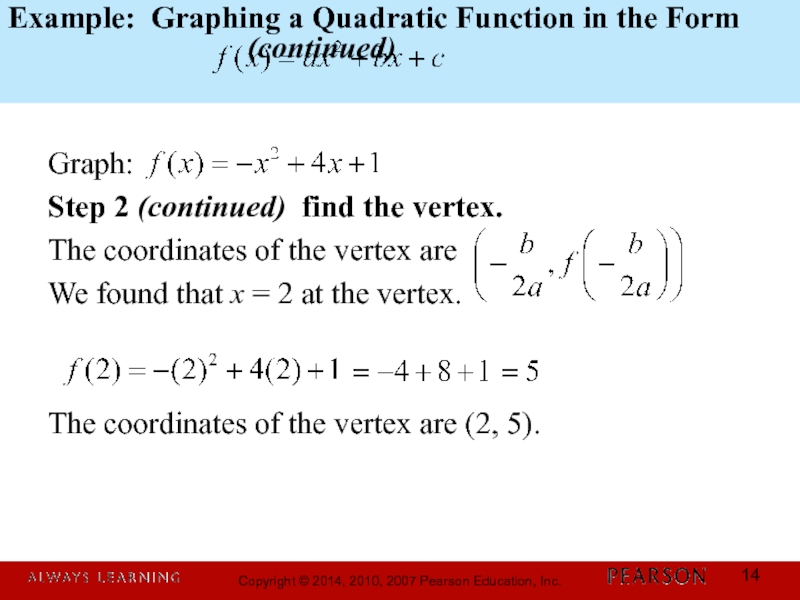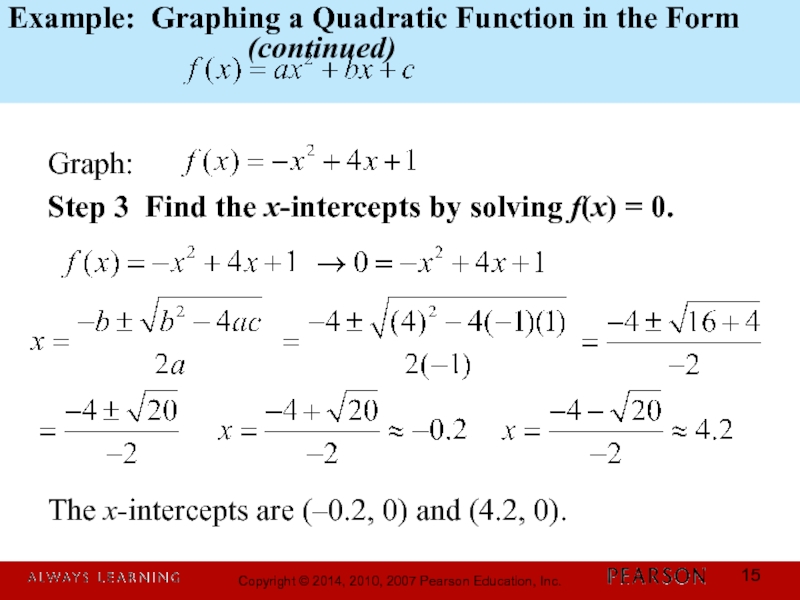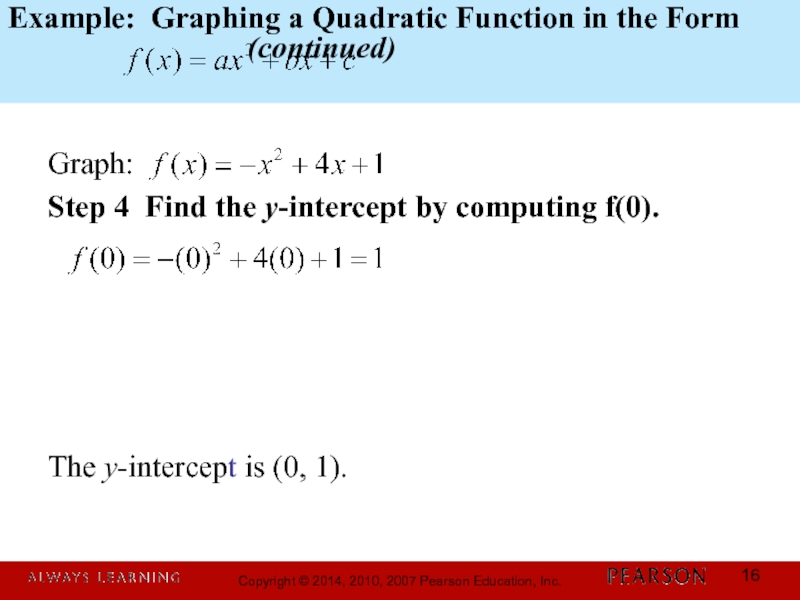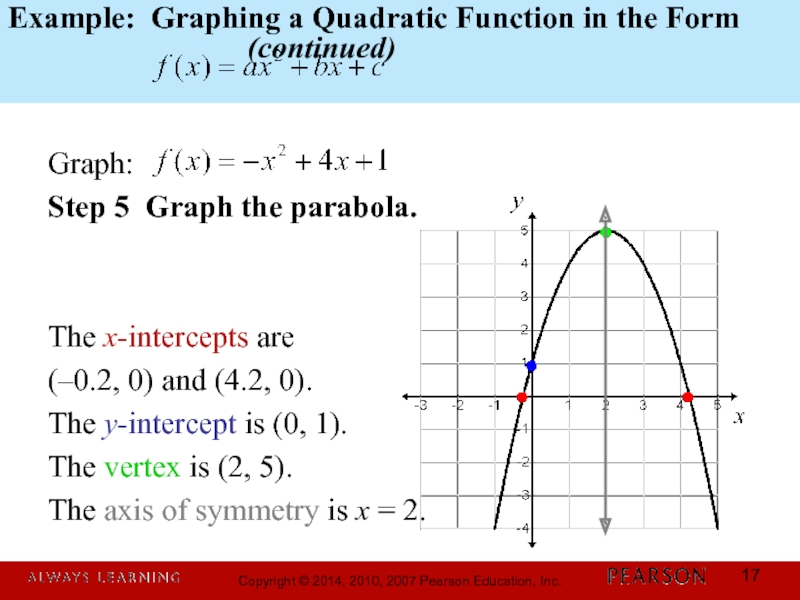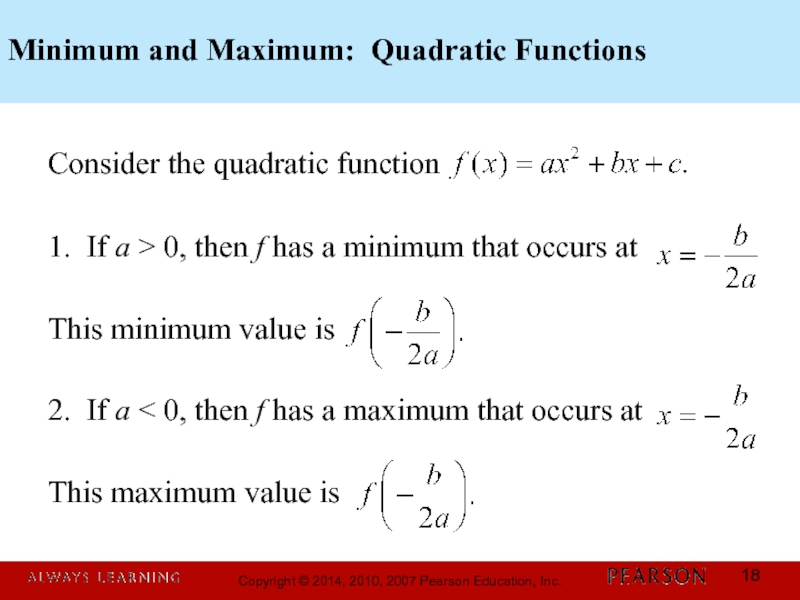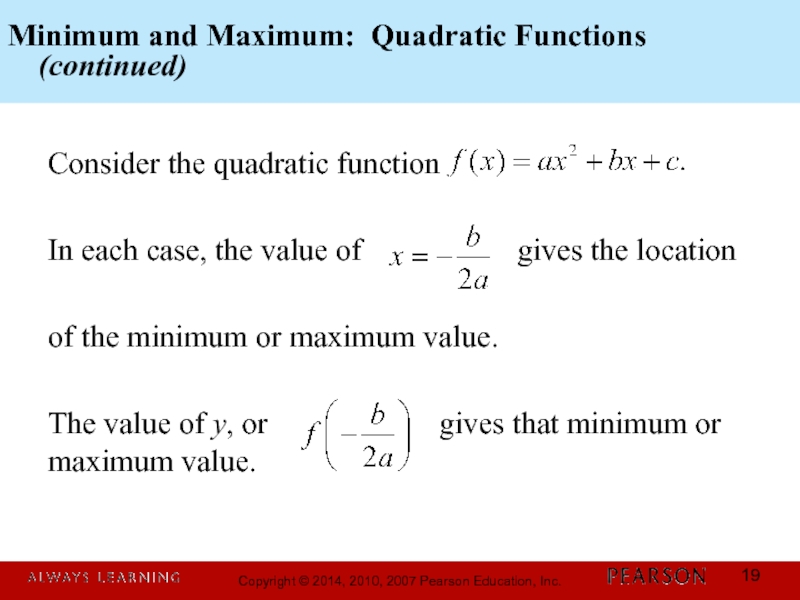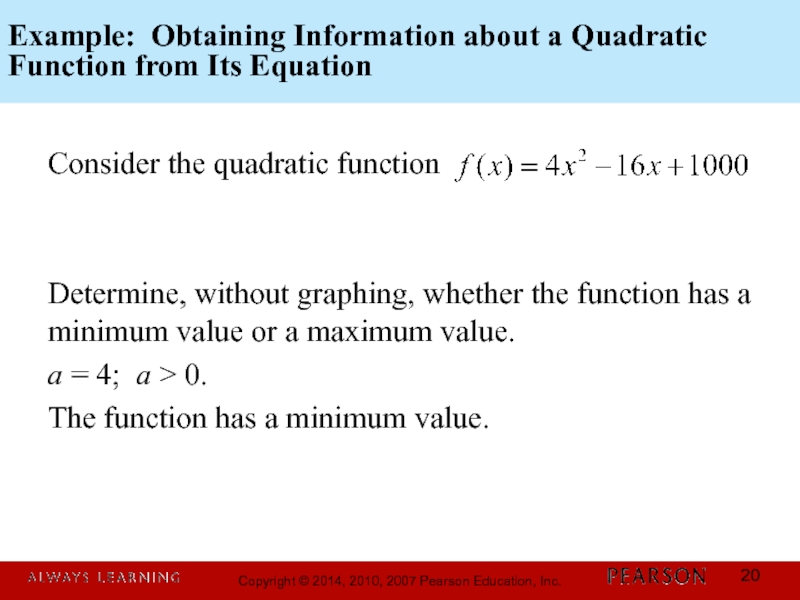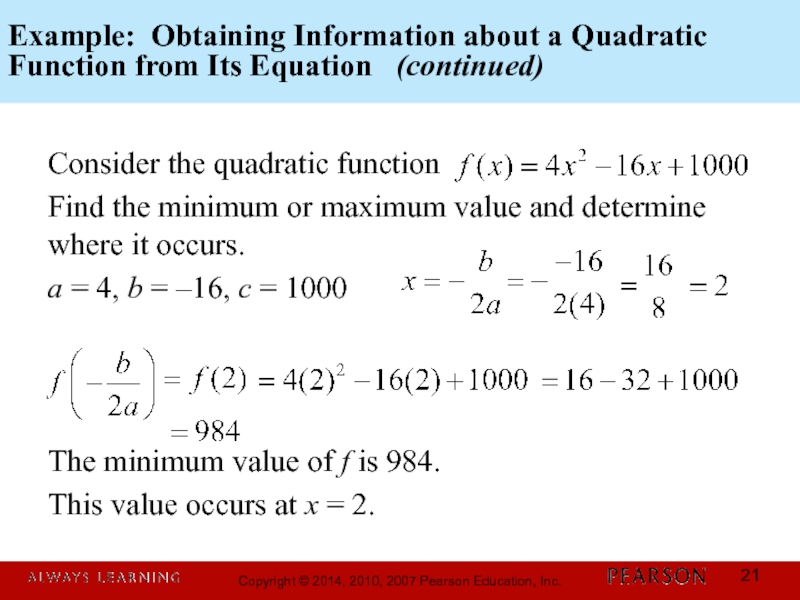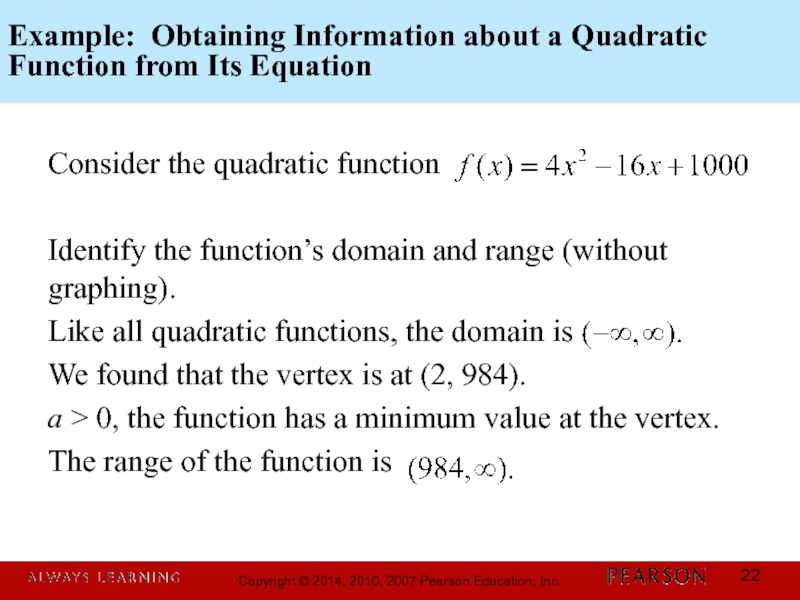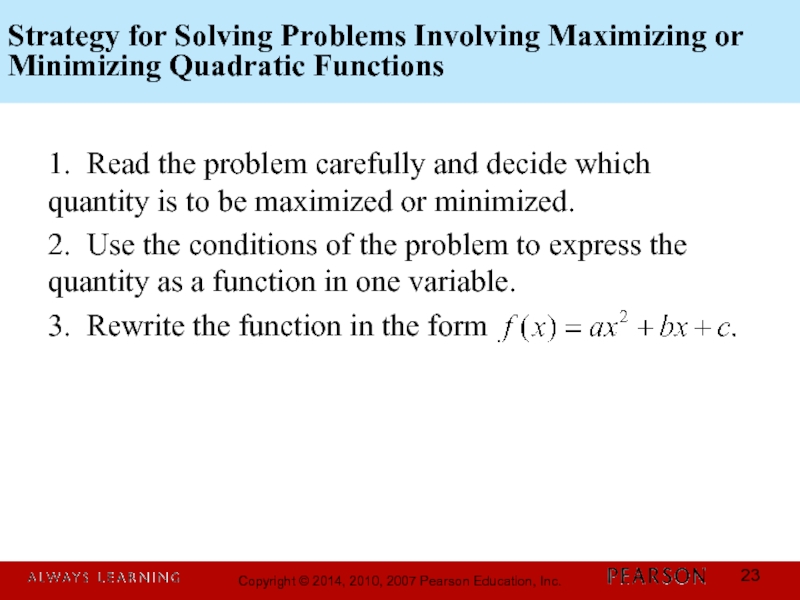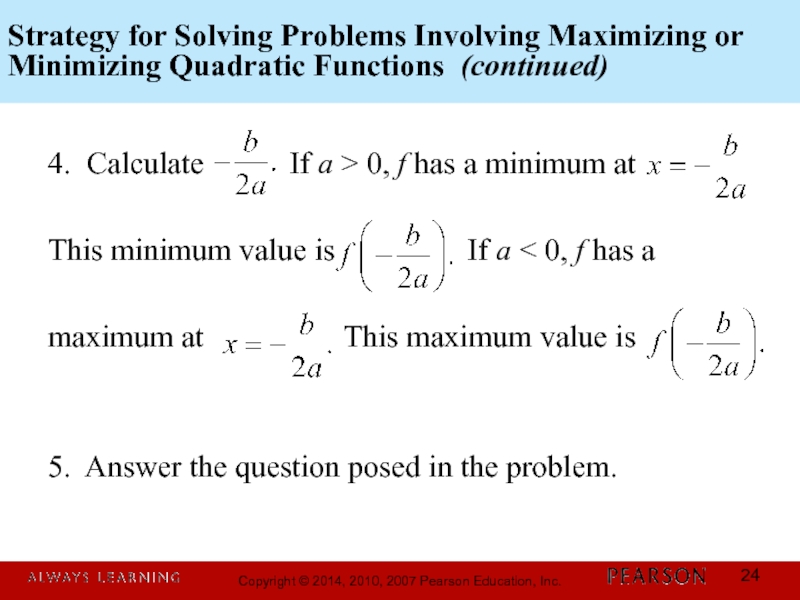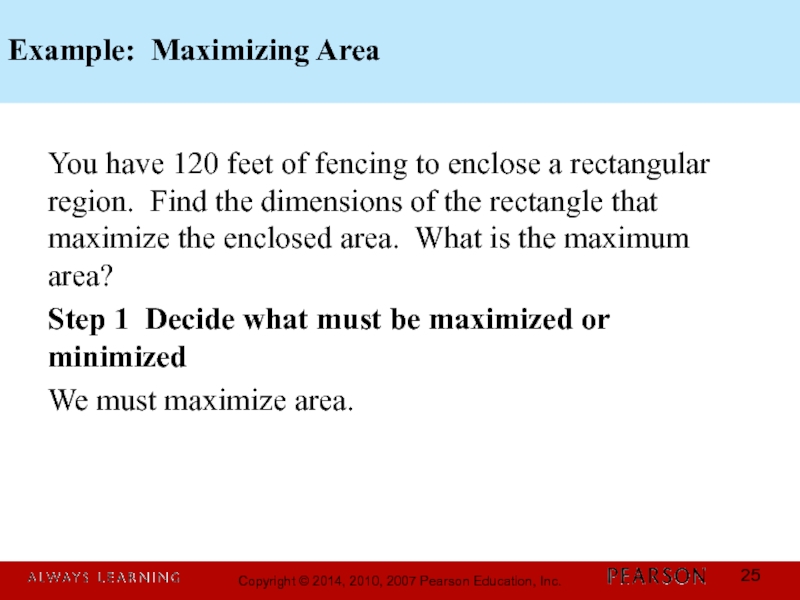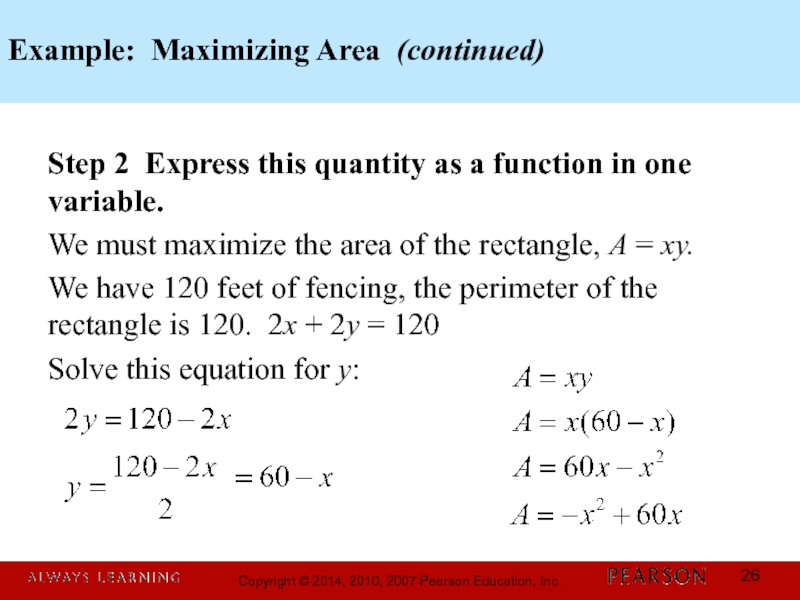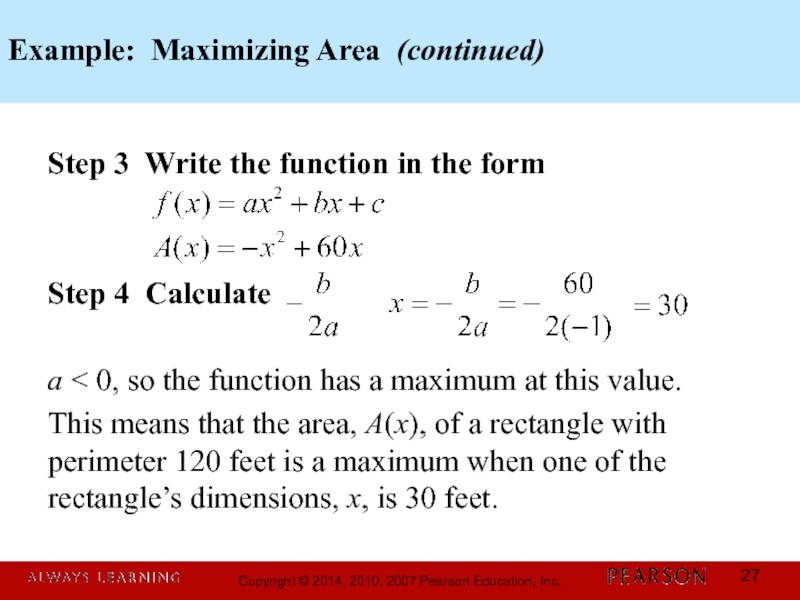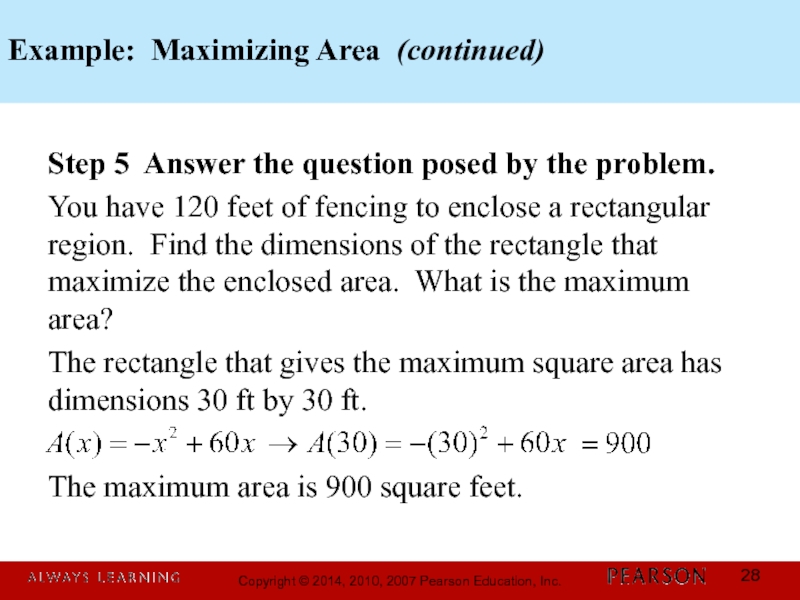3.1 Quadratic Functions
- Главная
- Разное
- Дизайн
- Бизнес и предпринимательство
- Аналитика
- Образование
- Развлечения
- Красота и здоровье
- Финансы
- Государство
- Путешествия
- Спорт
- Недвижимость
- Армия
- Графика
- Культурология
- Еда и кулинария
- Лингвистика
- Английский язык
- Астрономия
- Алгебра
- Биология
- География
- Детские презентации
- Информатика
- История
- Литература
- Маркетинг
- Математика
- Медицина
- Менеджмент
- Музыка
- МХК
- Немецкий язык
- ОБЖ
- Обществознание
- Окружающий мир
- Педагогика
- Русский язык
- Технология
- Физика
- Философия
- Химия
- Шаблоны, картинки для презентаций
- Экология
- Экономика
- Юриспруденция
Chapter 3. Polynomial and Rational Functions. 3.1 Quadratic Functions презентация
Содержание
- 1. Chapter 3. Polynomial and Rational Functions. 3.1 Quadratic Functions
- 2. Recognize characteristics of parabolas. Graph parabolas. Determine
- 3. The Standard Form of a Quadratic Function
- 4. Graphing Quadratic Functions with Equations in Standard
- 5. Graphing Quadratic Functions with Equations in Standard
- 6. Example: Graphing a Quadratic Function in Standard
- 7. Example: Graphing a Quadratic Function in Standard
- 8. Example: Graphing a Quadratic Function in Standard
- 9. Example: Graphing a Quadratic Function in Standard
- 10. The Vertex of a Parabola Whose Equation
- 11. Graphing Quadratic Functions with Equations in the
- 12. Graphing Quadratic Functions with Equations in the
- 13. Example: Graphing a Quadratic Function in the
- 14. Example: Graphing a Quadratic Function in the
- 15. Example: Graphing a Quadratic Function in the
- 16. Example: Graphing a Quadratic Function in the
- 17. Example: Graphing a Quadratic Function in the
- 18. Minimum and Maximum: Quadratic Functions Consider the
- 19. Minimum and Maximum: Quadratic Functions
- 20. Example: Obtaining Information about a Quadratic Function
- 21. Example: Obtaining Information about a Quadratic Function
- 22. Example: Obtaining Information about a Quadratic Function
- 23. Strategy for Solving Problems Involving Maximizing or
- 24. Strategy for Solving Problems Involving Maximizing or
- 25. Example: Maximizing Area You have 120 feet
- 26. Example: Maximizing Area (continued) Step 2 Express
- 27. Example: Maximizing Area (continued) Step 3 Write
- 28. Example: Maximizing Area (continued) Step 5 Answer
Слайд 1 Chapter 3
Polynomial and Rational Functions
Copyright © 2014, 2010, 2007 Pearson
Слайд 2Recognize characteristics of parabolas.
Graph parabolas.
Determine a quadratic function’s minimum or maximum
Solve problems involving a quadratic function’s minimum or maximum value.
Objectives:
Слайд 3The Standard Form of a Quadratic Function
The quadratic function
is in standard
Слайд 4Graphing Quadratic Functions with Equations in Standard Form
To graph
1. Determine whether
2. Determine the vertex of the parabola. The vertex is (h, k).
3. Find any x-intercepts by solving f(x) = 0. The function’s real zeros are the x-intercepts.
Слайд 5Graphing Quadratic Functions with Equations in Standard Form (continued)
To graph
4. Find
5. Plot the intercepts, the vertex, and additional points as necessary. Connect these points with a smooth curve that is shaped like a bowl or an inverted bowl.
Слайд 6Example: Graphing a Quadratic Function in Standard Form
Graph the quadratic function
Step
a = –1, a < 0; the parabola opens downward.
Step 2 Find the vertex.
The vertex is at (h, k). Because h = 1 and k = 4, the parabola has its vertex at (1, 4)
Слайд 7Example: Graphing a Quadratic Function in Standard Form (continued)
Graph:
Step 3
The x-intercepts are (3, 0) and (–1, 0)
Слайд 8Example: Graphing a Quadratic Function in Standard Form (continued)
Graph:
Step 4 Find
The y-intercept is (0, 3).
Слайд 9Example: Graphing a Quadratic Function in Standard Form
Graph:
The parabola opens
The x-intercepts are
(3, 0) and (–1, 0).
The y-intercept is (0, 3).
The vertex is (1, 4).
Слайд 10The Vertex of a Parabola Whose Equation is
Consider the parabola
The parabola’s vertex is
The x-coordinate is
The y-coordinate is found by substituting the
x-coordinate into the parabola’s equation and evaluating the function at this value of x.
Слайд 11Graphing Quadratic Functions with Equations in the Form
To graph
1. Determine
2. Determine the vertex of the parabola. The vertex is
3. Find any x-intercepts by solving f(x) = 0. The real solutions of are the x-intercepts.
Слайд 12Graphing Quadratic Functions with Equations in the Form
To graph
4. Find the y-intercept by computing f(0). Because
f(0) = c (the constant term in the function’s equation), the y-intercept is c and the parabola passes through
(0, c).
5. Plot the intercepts, the vertex, and additional points as necessary. Connect these points with a smooth curve.
Слайд 13Example: Graphing a Quadratic Function in the Form
Graph the quadratic function
Step
a = –1, a < 0, the parabola opens downward.
Step 2 Find the vertex.
The x-coordinate of the vertex is
a = –1, b = 4, and c = 1
Слайд 14Example: Graphing a Quadratic Function in the Form
(continued)
Graph:
Step 2 (continued) find
The coordinates of the vertex are
We found that x = 2 at the vertex.
The coordinates of the vertex are (2, 5).
Слайд 15Example: Graphing a Quadratic Function in the Form
(continued)
Graph:
Step 3 Find the
The x-intercepts are (–0.2, 0) and (4.2, 0).
Слайд 16Example: Graphing a Quadratic Function in the Form
(continued)
Graph:
Step 4 Find the
The y-intercept is (0, 1).
Слайд 17Example: Graphing a Quadratic Function in the Form
(continued)
Graph:
Step 5 Graph
The x-intercepts are
(–0.2, 0) and (4.2, 0).
The y-intercept is (0, 1).
The vertex is (2, 5).
The axis of symmetry is x = 2.
Слайд 18Minimum and Maximum: Quadratic Functions
Consider the quadratic function
1. If a >
This minimum value is
2. If a < 0, then f has a maximum that occurs at
This maximum value is
Слайд 19Minimum and Maximum: Quadratic Functions
(continued)
Consider the quadratic function
In
of the minimum or maximum value.
The value of y, or gives that minimum or maximum value.
Слайд 20Example: Obtaining Information about a Quadratic Function from Its Equation
Consider the
Determine, without graphing, whether the function has a minimum value or a maximum value.
a = 4; a > 0.
The function has a minimum value.
Слайд 21Example: Obtaining Information about a Quadratic Function from Its Equation
Consider the quadratic function
Find the minimum or maximum value and determine where it occurs.
a = 4, b = –16, c = 1000
The minimum value of f is 984.
This value occurs at x = 2.
Слайд 22Example: Obtaining Information about a Quadratic Function from Its Equation
Consider the
Identify the function’s domain and range (without graphing).
Like all quadratic functions, the domain is
We found that the vertex is at (2, 984).
a > 0, the function has a minimum value at the vertex.
The range of the function is
Слайд 23Strategy for Solving Problems Involving Maximizing or Minimizing Quadratic Functions
1. Read
2. Use the conditions of the problem to express the quantity as a function in one variable.
3. Rewrite the function in the form
Слайд 24Strategy for Solving Problems Involving Maximizing or Minimizing Quadratic Functions (continued)
4.
This minimum value is If a < 0, f has a
maximum at This maximum value is
5. Answer the question posed in the problem.
Слайд 25Example: Maximizing Area
You have 120 feet of fencing to enclose a
Step 1 Decide what must be maximized or minimized
We must maximize area.
Слайд 26Example: Maximizing Area (continued)
Step 2 Express this quantity as a function
We must maximize the area of the rectangle, A = xy.
We have 120 feet of fencing, the perimeter of the rectangle is 120. 2x + 2y = 120
Solve this equation for y:
Слайд 27Example: Maximizing Area (continued)
Step 3 Write the function in the form
Step
a < 0, so the function has a maximum at this value.
This means that the area, A(x), of a rectangle with perimeter 120 feet is a maximum when one of the rectangle’s dimensions, x, is 30 feet.
Слайд 28Example: Maximizing Area (continued)
Step 5 Answer the question posed by the
You have 120 feet of fencing to enclose a rectangular region. Find the dimensions of the rectangle that maximize the enclosed area. What is the maximum area?
The rectangle that gives the maximum square area has dimensions 30 ft by 30 ft.
The maximum area is 900 square feet.

